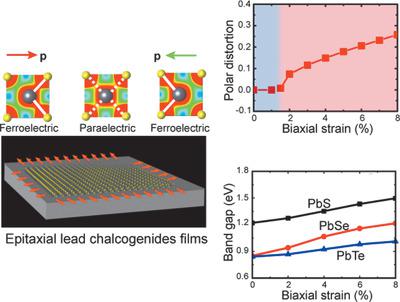当前位置:
X-MOL 学术
›
Adv. Electron. Mater.
›
论文详情
Our official English website, www.x-mol.net, welcomes your
feedback! (Note: you will need to create a separate account there.)
Strain Engineering for 2D Ferroelectricity in Lead Chalcogenides
Advanced Electronic Materials ( IF 5.3 ) Pub Date : 2019-11-18 , DOI: 10.1002/aelm.201900932 Tao Xu 1 , Xiaoyuan Wang 2 , Jiawei Mai 1 , Jingtong Zhang 3 , Jie Wang 3 , Tong‐Yi Zhang 1
Advanced Electronic Materials ( IF 5.3 ) Pub Date : 2019-11-18 , DOI: 10.1002/aelm.201900932 Tao Xu 1 , Xiaoyuan Wang 2 , Jiawei Mai 1 , Jingtong Zhang 3 , Jie Wang 3 , Tong‐Yi Zhang 1
Affiliation

|
The quest for new 2D ferroelectric materials continues to arouse interest. Based on first‐principles calculations, here, 2D ferroelectric properties in lead chalcogenides PbXs (X = S, Se, and Te) with a thickness of two atomic layers via strain engineering is demonstrated. Although these materials are stable in a rocksalt‐type cubic structure and are intrinsically nonferroelectric materials, an appropriate mechanical strain can readily activate a paraelectric to ferroelectric phase transition and induce in‐plane electric polarization in these atomic layers. The induced polarization magnitude can be as large as 1.90 × 10−10 C m−1 at a biaxial strain of ε = 4.0%, which is comparable in magnitude to that of ultrathin ferroelectric SnTe. The Curie temperature Tc of the materials is also estimated using effective Hamiltonian simulations. The origin of the emerged ferroelectric phase is attributed to softening of the polar mode with applied strain. In addition, the band gaps of the crystals are found to be tunable with applied strain, which can be adjusted to the ideal value of 1.3 eV for photovoltaic applications. The results not only provide a new route to explore ferroelectricity in 2D materials but also suggest promising semiconducting ferroelectrics for solar applications.
中文翻译:

硫族铅化物中二维铁电的应变工程
对新型2D铁电材料的追求继续引起人们的兴趣。基于第一性原理计算,此处通过应变工程论证了具有两个原子层厚度的硫族铅铅化物PbXs(X = S,Se和Te)中的二维铁电特性。尽管这些材料在岩石盐型立方结构中是稳定的,并且本质上是非铁电材料,但是适当的机械应变可以轻松地激活顺电向铁电的相变,并在这些原子层中引起面内极化。在ε= 4.0%的双轴应变下,感应极化强度可以高达1.90×10 -10 C m -1,其大小与超薄铁电SnTe相当。居里温度T c还使用有效的汉密尔顿模拟来估算材料的数量。出现的铁电相的起源归因于施加应变时极性模态的软化。此外,发现晶体的带隙可以通过施加的应变来调节,对于光伏应用,可以将其调整为理想的1.3 eV值。结果不仅为探索2D材料中的铁电提供了一条新途径,而且还提出了在太阳能应用中很有希望的半导体铁电材料。
更新日期:2020-01-13
中文翻译:

硫族铅化物中二维铁电的应变工程
对新型2D铁电材料的追求继续引起人们的兴趣。基于第一性原理计算,此处通过应变工程论证了具有两个原子层厚度的硫族铅铅化物PbXs(X = S,Se和Te)中的二维铁电特性。尽管这些材料在岩石盐型立方结构中是稳定的,并且本质上是非铁电材料,但是适当的机械应变可以轻松地激活顺电向铁电的相变,并在这些原子层中引起面内极化。在ε= 4.0%的双轴应变下,感应极化强度可以高达1.90×10 -10 C m -1,其大小与超薄铁电SnTe相当。居里温度T c还使用有效的汉密尔顿模拟来估算材料的数量。出现的铁电相的起源归因于施加应变时极性模态的软化。此外,发现晶体的带隙可以通过施加的应变来调节,对于光伏应用,可以将其调整为理想的1.3 eV值。结果不仅为探索2D材料中的铁电提供了一条新途径,而且还提出了在太阳能应用中很有希望的半导体铁电材料。











































 京公网安备 11010802027423号
京公网安备 11010802027423号